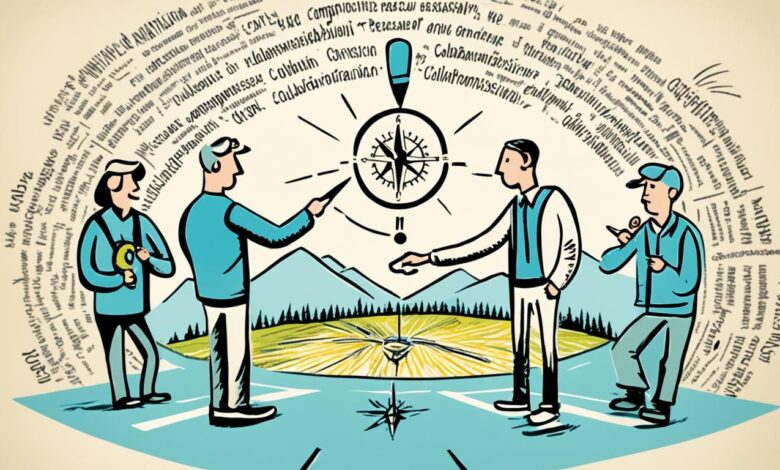Understanding Conflict vs. Disagreement Explained

Sometimes, we stand at a crossroad, unsure if we’re just differing in opinion or stuck in something deeper. The line between conflict vs. disagreement is crucial—it defines how we handle and move through complex social interactions. Knowing the difference is key in dealing with disagreement well and using conflict resolution techniques right. As we talk more and agree less, grasping this concept isn’t just helpful—it’s essential. But knowing where to draw the line is hard. Why is it so important?
Let’s explore the true nature behind our interpersonal struggles, dissecting what really separates minor disputes from major issues. Hold off on making quick judgments. What we uncover might shift how we view and tackle every argument or conversation. Perhaps, we don’t just need solutions, but a new way to see and talk about our problems. Join us on this exploration to understand and clearly differentiate these ideas. With this understanding, we can turn every conflict into a chance for teamwork and personal growth.
Delineating the Definitions: Conflict vs. Disagreement
When we talk about people getting along, it’s key to know the difference between ‘conflict’ and ‘disagreement’. Although similar, they are not the same. Knowing this helps fix problems better, especially at work.
John Burton’s Distinction
John Burton, a smart thinker, helps us see how they’re different. He says a disagreement is just a small problem that can be solved by talking it out. It’s like a minor bump in the road that we can smooth over with a good chat. This idea is super helpful for solving problems at work with a little give and take.
How Disputes Relate to Conflicts
Conflicts, however, are big deals. They are not just small bumps but huge barriers that are hard to break down. They come from deeper issues, like personal grudges or big workplace problems. Knowing the difference helps us not just put a band-aid on it but really fix what’s wrong underneath.
This is really important for bosses and HR folks to understand. It guides how they fix not just small fights but how they make the workplace better for everyone.
Perceptions of Conflict and Dispute in Mediation
In the world of mediation, how we see conflict and dispute is very important. It influences the results of mediation. Mediators use conflict resolution techniques They don’t just solve the fight at hand. They also look into deeper problems that caused the conflict.
Mediation’s Role in Conflict Interpretation
Mediators do more than just use set conflict management strategies. They dig into what makes a simple disagreement different from a serious conflict. Timothy Keator, an expert in mediation, stresses looking into these differences. This helps lead the parties to solve their issues for good, not just stop fighting for a bit.
The Difference in Dispute Resolution and Conflict Resolution Techniques
Mediators need to know how dispute resolution and conflict resolution techniques differ. Solving disputes might mean finding common ground. But solving conflicts goes deeper. It looks at what each side really needs and feels. The secret to how to resolve conflict in mediation is understanding and working through these differences. This leads to agreements that last and keep peace.
The Nature of Conflict: Insight from Experts
Exploring conflict means looking at how people talk and act with each other. It shows up when people or groups don’t agree. This disagreement can grow into bigger problems. That’s why understanding how to manage different kinds of conflicts is so important.

Interactive and Communicative Factors
Experts believe conflict is all about communication. How people interact with each other can shape the conflict. Misunderstandings or fights, whether at work or in relationships, highlight the importance of managing conflicts well.
Incompatibilities Leading to Conflict
Differences in beliefs or goals can hurt relationships. These issues pop up everywhere, from work to home. Knowing the types of conflict helps in solving these problems.
| Type of Conflict | Characteristics | Conflict Management Strategies |
|---|---|---|
| Interpersonal Conflict | Occurs between individuals due to personal differences | Active listening, empathy, negotiation |
| Intragroup Conflict | Arises within a group, often around task distribution | Clarification of roles, mediation, fostering team cohesion |
| Intergroup Conflict | Stems from competition or differences between groups | Inter-group dialogue, seek common goals, peacebuilding activities |
| Organizational Conflict | Originates within an organization due to structural or role conflicts | Organizational restructuring, transparent communication, conflict resolution training |
| International Conflict | Occurs between nations or cultural groups over varied interests | Diplomatic negotiations, treaties, international mediation |
The Mediator’s Approach to Conflict Analysis
Mediators act as impartial helpers in resolving disputes. They help people deal with disagreements moving them towards positive change. Mediation delves into conflicts deeply, offering insight. A mediator’s job is also to dig into deeper issues and enhance empowerment.
Fostering Empowerment Through Mediation
Empowerment is key in mediation. It makes everyone involved feel important and listened to. It inspires them to see resolutions as reachable and conflicts as chances for enrichment. By using smart conflict resolution techniques, mediators promote independence and cooperative solution-finding.
Understanding Parties’ Interests and Goals
The heart of mediation is knowing what everyone really wants. This understanding helps resolve conflicts by viewing them as opportunities for agreement. Lawyers and mediators work to create a non-adversarial environment. They aim for a resolution that reflects everyone’s needs and aspirations, not just to find a winner.
Getting into the Mediation Mindset
Stepping into mediation requires a special mindset. This includes neutrality and objective facilitation. It’s tough but necessary. Professionals rely on conflict management strategies and knowledge of conflict resolution techniques. They must make smart decisions and manage emotions well. This helps them handle talks that are tricky but productive.
The Role of Neutrality and Objective Facilitation
Being neutral is key in mediation. A fair mediator keeps things balanced. They ensure everyone feels listened to and understood. Dealing with disagreement well means building trust. It also means encouraging honest discussions. The right mix of stepping back and getting involved helps avoid fights and find harmony.
Creating a Collaborative Environment
Mediation isn’t just about agreeing. It’s about making a space where everyone’s opinion matters. The mediator uses conflict resolution techniques to set an example. They show that different needs can work together well. This kind of space lets people look deeper into the issue. It helps find solutions that last and make everyone happy.
Conflict vs. Disagreement in Relationships
The disagreement definition in relationships is about differing views or opinions. These can usually be talked over and resolved with good conversation. On the other hand, conflict means more serious issues where people’s core values clash. This leads to communication breakdowns and rising tensions. Understanding how to deal with disagreement and prevent conflict is crucial for keeping a relationship healthy.

Disagreement in relationships is normal and can be part of a healthy partnership. It lets each person share their personal needs and wants. But, when disagreements turn into conflicts, the peace of the relationship is at risk. This part looks at ways couples can work through disagreements. The goal is to steer clear of conflicts by keeping conversations respectful and understanding.
| Disagreement | Conflict |
|---|---|
| Negotiable differences in opinion | Non-negotiable differences affecting core values |
| Can be resolved through dialogue | Often requires deeper intervention to resolve |
| Potential for personal and relational growth | Can lead to resentment and deterioration of the relationship |
| Emphasizes mutual respect and compromise | May result in power struggles and win-lose situations |
To conclude, using empathy, openness, and a willingness to compromise is very important. This isn’t just for handling disagreement, but also for avoiding serious conflicts. Understanding disagreement in relationships gives partners a chance to get to know each other better. It strengthens their connection through effective communication.
Detecting and Addressing Conflicts
Conflicts happen when we interact with others. Solving them is key in both personal and work life. Knowing how to find and deal with conflicts is an important skill. It includes learning different ways to manage conflicts. To choose the best way to solve a problem, we must first understand the feelings involved.
The Role of Rapport and Trust in Identifying Conflicts
Building trust and rapport is crucial in resolving conflicts. It helps in communicating openly and finding the real issues. In work settings, mutual respect leads to honest discussions. This helps spot tensions early. Catching these signs early is key to solving conflicts before they grow.
Strategies to Navigate from Dispute to Resolution
To move from disagreement to agreement, knowing the right strategies is a must. It’s important to focus on why people feel a certain way, not just what they think. This can help understand each other better and calm negative feelings.
Below is a table of key strategies for handling conflicts. These methods are essential for anyone who wants to fix disagreements or conflicts.
| Strategy | Objective | Application in Conflict Resolution |
|---|---|---|
| Active Listening | Validating participants’ perspectives | Allows parties to feel understood and valued, establishing a platform for mutual trust |
| Emotional Intelligence | Recognizing and understanding emotions | Enables the mediator to navigate and reduce emotional barriers to resolution |
| Problem-solving | Developing creative solutions | Facilitates a shift from opposing stances to collaborative outcomes |
| Controlled Dialogue | Maintaining a focused discussion | Prevents digression and escalation by keeping the conversation on track |
Adding these strategies to your conflict management toolbox is powerful. They work well in both personal and work disputes. Using these techniques can lead to great results.
The Mediation Process and Techniques
The art of mediation blends different elements to create harmony and agreement. It involves a complex communication process, using conflict management strategies. Mediators apply a variety of conflict resolution techniques to connect diverse viewpoints. This helps in finding mutual understanding and solutions.
Active Listening and Empathy in Mediation
Active listening stands at the core of mediation. It shows the mediator’s efforts to fully grasp what all parties say. This skill is vital in how to resolve conflict. It encourages an empathetic setting where everyone feels acknowledged.
Using active listening builds trust. It starts the foundation for working together on solutions.
Utilizing Neutral Reframing and Summarization
Neutral reframing is key in mediation. It helps restate problems without the emotional biases, making issues clearer to all. Along with this, summarization helps capture and clarify the main points discussed. It makes sure everyone’s points are understood and considered.
| Mediation Technique | Description | Impact on Resolution |
|---|---|---|
| Active Listening | Mediator attentively listens and demonstrates understanding of the speaker’s message. | Builds empathy and rapport, fostering an atmosphere of trust and collaboration. |
| Neutral Reframing | Rephrasing the problem in unbiased terms to avoid escalation and confrontational language. | Reduces defensive reactions, allowing parties to view issues more objectively. |
| Summarization | Mediator recaps the main points to clarify and confirm mutual understanding. | Ensures that party’s viewpoints are recognized, promoting engagement and validation. |
By using these techniques thoughtfully, mediators guide conversations towards peaceful outcomes. Skillful use of conflict resolution techniques and conflict management strategies helps mediators steer through tough disputes. This leads to calm and agreeable solutions.
Understanding Conflict Resolution Techniques
Understanding the difference between conflict and disagreement is key to solving issues well. Conflict resolution is like playing chess, not a quick fix. It involves thinking about every step carefully. With a calm approach, we can manage conflicts smartly. This way, we can turn disagreements into constructive conversations, benefiting everyone involved.
Managing Emotions and Agendas
Managing emotions is vital in resolving conflicts, important in all areas of life. Emotional intelligence helps us understand and control our feelings during conflict. This means looking beyond the obvious problems to find the real issues underneath. When we carefully handle emotions and intentions, finding a solution becomes easier. This leads to mutual respect and understanding.
Implementing Constructive Solutions
Constructive results come from using conflict resolution to build, not break, relationships. Effective solutions respect everyone’s concerns and promote compromises for the common good. By doing this, we all play a part in creating a better future together. This makes resolution a way to end conflicts and strengthen relationships, preparing us to meet future challenges together.



